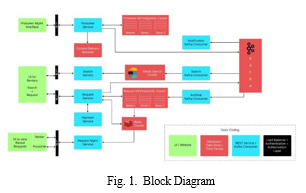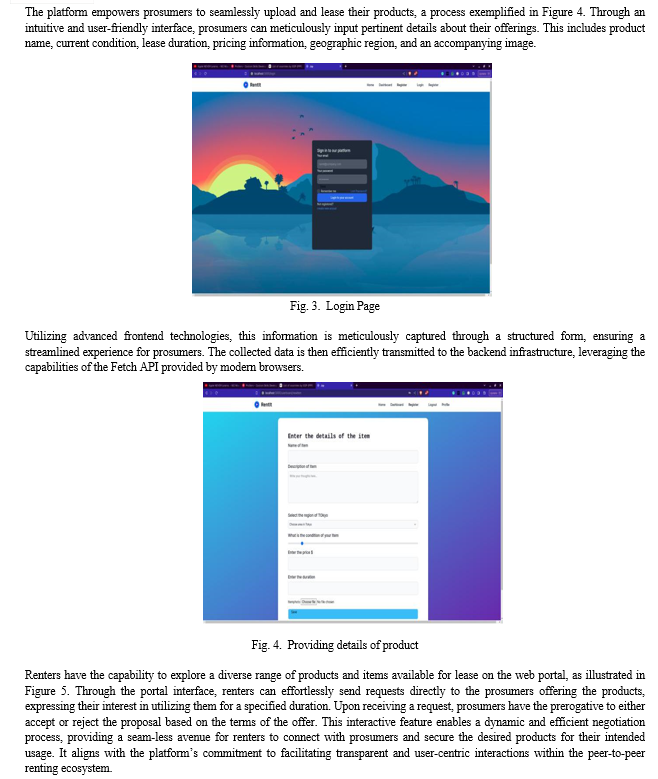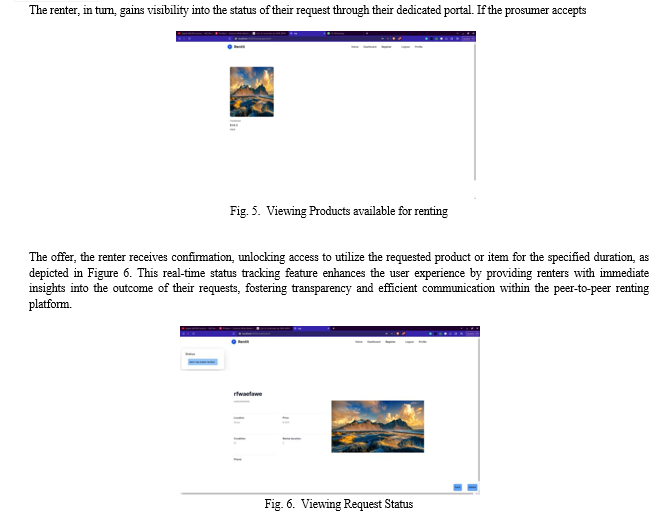Ijraset Journal For Research in Applied Science and Engineering Technology
- Home / Ijraset
- On This Page
- Abstract
- Introduction
- Conclusion
- References
- Copyright
RentIt: A Peer To Peer Asset Sharing Platform
Authors: Amrit Raj, Ankit Sharma, Kartikeya Vishnoi, Kumar Aryan, Assistant Prof. Chaitra SP
DOI Link: https://doi.org/10.22214/ijraset.2024.57837
Certificate: View Certificate
Abstract
This paper introduces RentIt, an innovative Peer-to-Peer (P2P) rental platform aimed at revolutionizing resource access and sharing. The RentIt system is designed to facilitate seamless connections and transactions among users within a secure and user-friendly environment. Users can effortlessly list, discover, and rent a diverse array of items from fellow users, optimizing the utilization of underutilized assets. The RentIt platform is built on cutting-edge technology, emphasizing trust and transparency in peer-to-peer transactions. Through this system, individuals gain the ability to share their resources with others, contributing to a more sustainable and collaborative community. The platform’s user-friendly interface ensures an efficient and reliable experience for both lenders and renters. This paper details the architecture and functionality of RentIt, highlighting its role in transforming conventional resource man-agement practices. It emphasizes the importance of maximizing the utility of idle assets, promoting a culture of responsible consumption, and fostering a sense of community through shared resources.
Introduction
I. INTRODUCTION
In the contemporary landscape of resource management and consumption, the emergence of peer-to-peer (P2P) rental platforms has significantly altered traditional paradigms. This paper introduces ”RentIt,” a cutting-edge P2P rental platform designed to revolutionize the access and sharing of resources. RentIt presents a transformative solution that empowers indi-viduals to connect seamlessly, fostering a collaborative envi-ronment for the efficient exchange of underutilized assets.
A. Background and Motivation
In a society marked by evolving consumer patterns and environmental consciousness, there is a growing need for innovative systems that promote responsible consumption and sustainable resource utilization. RentIt addresses this need by offering a dynamic platform that facilitates the listing, discovery, and rental of a diverse range of items among users. The motivation behind RentIt lies in its potential to redefine the way individuals access and utilize resources, ultimately contributing to a more sustainable and interconnected com-munity.
B. Objectives of RentIt
The primary objective of RentIt is to establish a user-friendly and trusted environment where individuals can seam-lessly transact with one another. By leveraging the power of collaborative consumption, RentIt aims to maximize the utility of assets that would otherwise remain underutilized. Through this platform, users can optimize their resource usage, reducing waste and contributing to a more sustainable and efficient economy.
C. Scope of the Paper
This paper comprehensively explores the architecture, func-tionality, and impact of RentIt. It provides insights into the technological innovations that underpin the platform, empha-sizing its potential to transform conventional resource manage-ment practices. Additionally, the paper delves into the societal implications of RentIt, emphasizing its role in fostering a culture of responsible consumption and community-driven resource sharing.
D. Contribution of RentIt
RentIt represents a significant contribution to the evolving landscape of collaborative consumption and P2P transactions. This paper aims to shed light on the unique features of RentIt, showcasing its potential to empower individuals, promote sustainability, and redefine the dynamics of resource sharing in the modern era.
Keywords: P2P Rental, Collaborative Consumption, Re-source Sharing, Sustainable Community, User-Friendly Plat-form, Trustworthy Transactions.
II. LITERATURE SURVEY
- A quantitative security evaluation and analysis model for web applications based on OWASP application security verification standard (Authors: Shao-Fang Wen, Basel Katt) In today’s digital landscape, web applications are widely used by businesses, but they are also attractive targets for cyberattacks due to potential security gaps. Organizations need effective ways to assess the security of their web-based software to protect against data breaches and service disruptions. This research aims to enhance the quantitative analysis of web application security by integrating the Open Web Application Security Project’s (OWASP) Application Security Verification Standard (ASVS) into a structured model. This model allows for efficient evaluation of web application security, providing valuable insights into their strengths and weaknesses.
- Resource-constrained replanning in MATSim applied to the simulation of peer-to-peer car sharing services (Authors: Sebastian Horl,¨ Jeremy Sobieraj, Steffen Axer, Hannes Re-wald) Peer-to-peer car sharing is a service model in which car owners let others use their vehicle while it is not in use by themselves. To simulate such a service in the agent-based transport simulation framework MATSim, a novel synchro-nization concept is proposed that considers limited resources in the decision-making of the agents. The concept is introduced in detail and demonstrated for peer-to-peer car sharing on a conceptual use case and a large-scale simulation for Berlin. The concept is generalizable to other constrained resources, such as parking or micromobility.
- Authentication and Authorization in Modern Web Apps for Data Security Using Nodejs and Role of Dark Web (Au-thors: Piyush Pant, Anand Singh Rajawat, S.B. Goyal, Pradeep Bedi, Chaman Verma, Maria Simona Raboaca, Florentina Magda Enescu¬) The paper highlights the need for secure websites to safeguard user data and trust between clients and servers. It centers on creating an authentication system using NodeJS, especially with expressJS, offering insights into server-side details and recommending effective authentication methods for web security. Additionally, it explores the future potential of Artificial Intelligence and blockchain in fortifying big data security.
- Subscription price and advertising space decisions for on-line content firms with reference effect (Authors: Jian Xu, Yon-grui Duan) This paper explores how online content providers decide subscription prices and ad space allocation, considering the reference price effect. They examine a hybrid model with subscriptions and ads for viewers. The study introduces a reference price model incorporating viewer experience and finds that a hybrid model isn’t always best. When viewers care less about ads, a subscription-only model is preferable. Also, reducing ad space is recommended when viewer experience matters more. In dynamic scenarios, the stable subscription price might not align with the reference price. Neglecting the reference effect can lead to profit overestimation for low initial reference prices and underestimation for high ones.
- Handling security issues by using homomorphic encryp-tion in multi-cloud environment (Authors: Yulliwas Ameur, Samia Bouzefrane, Le Vinh Thinh) Using cloud computing for data storage is popular, but data security is a challenge. To address this, a multi-cloud platform is proposed, combining public, private, and managed clouds with one user interface. Data is distributed across multiple data centers based on cloud reliability and data sensitivity. Current encryption is resource-intensive, expensive, and requires decryption for processing. Homomorphic encryption allows data to be processed while encrypted, enabling analysis without revealing the data. This paper explores multi-cloud security solutions using homomor-phic encryption, identifying areas for improvement.
- Security testing of web applications: A systematic map-ping of the literature (Authors: Murat Aydos, C¸igdem? Al-dan, Evren Cos¸kun, Alperen Soydan) This study conducts a systematic literature mapping to address the challenge of navigating the extensive research in web application security testing. It identifies 80 technical articles published between 2005 and 2020, providing a comprehensive overview of the field, including contributions, security testing tools, vulnera-bilities, and systems under testing. Valuable for researchers and web developers, it offers insights and trends to improve web application security.
- Privacy and Security in Internet-based Computing: Cloud Computing, Internet of Things, Cloud of Things: a review (Authors: Syrine Sahmim, Hamza Gharsellaoui) This paper gives insights into the most important existing problems of security and privacy of the Cloud Computing (CC), Internet of Things (IoT) and Cloud of Things (CoT) concepts especially confidentiality issue. With the evolution of ubiquitous com-puting, everything is connected everywhere, therefore these concepts have been widely studied in the literature. However, intrusions and vulnerabilities will be more recurrent due to the systems complexity and the difficulty to control each access attempt. To tackle this issue, researchers have been focused on various approaches enforcing security and privacy. In the present paper, risk factors and solutions regarding these technologies are reviewed then current and future trends are discussed.
- Understanding collaborative consumption: Test of a theoretical model (Authors: J. Barnes, Jan Mattsson) This study explores consumer behavior in collaborative consump-tion websites where people share rather than own products. It creates a theoretical model and tests it using data from a car-sharing website. The findings show that consumers’ intentions to rent items are influenced by economic, environmental, and social benefits, which are linked to how useful and enjoyable they find the sharing community. Surprisingly, social influence doesn’t have a significant role. When recommending the service, consumers also consider website trust, which is based on the website’s reliability. This research has implications for both theory and practice in the collaborative consumption space.
- An approach for benchmarking the security of web service frameworks (Authors: Rui Andre´ Oliveira, Miquel, Mart´?nez Raga, Nuno Laranjeiro, Marco Vieira) The paper introduces a security benchmark for assessing and comparing web service frameworks. It consists of two phases: identifying vulnerabilities in the frameworks and assessing their trustwor-thiness. The study applied this approach to ten frameworks in the context of DoS attacks, finding that six did not qualify for the trustworthiness assessment. The benchmark allows developers to make informed choices about deploying secure web services. To enhance web service security, the benchmark initially detects vulnerabilities, and if found, disqualifies the frameworks. The remaining frameworks are then ranked based on their trustworthiness, providing valuable guidance for de-velopers in their framework selection.
- Assessing the security of web service frameworks against Denial of Service attacks (Authors: Rui Andre´ Oliveira, Nuno Laranjeiro, Marco Vieira) This paper focuses on the critical issue of security for web services, particularly in defending against Denial of Service (DoS) attacks. It introduces an experimental approach to assess the readiness of web service frameworks in handling DoS attacks. The study involves executing a range of DoS attacks on six frameworks and classifying their responses. The results reveal that four of the frameworks are vulnerable to at least one type of DoS attack, highlighting the need for immediate security enhancements, even in widely used platforms.
III. METHODOLOGY AND FRAMEWORK
RentIt, an innovative web application, embodies a com-prehensive and dynamic development stack that seamlessly integrates various technologies to deliver a robust and user-centric platform. At the core of its backend operations is Ruby on Rails, a versatile and developer-friendly framework known for its convention over configuration and rapid development capabilities. This choice ensures RentIt’s backend is not only scalable but also efficient, providing a solid foundation for seamless data processing and business logic implementation.

Complementing the powerful backend, the frontend of Ren-tIt is crafted with Rails UI, HTML, and Tailwind CSS. This combination offers a winning formula for creating an intuitive and high-performance user interface. Rails UI provides ready-to-use components and structures, while HTML serves as the standard markup language, making the frontend development process both efficient and familiar. Tailwind CSS, with its utility-first approach, adds a layer of flexibility and consistency to the styling, allowing for the creation of visually appealing and responsive user interfaces.
In the realm of data management, RentIt leverages Post-greSQL during development. Chosen for its scalability, flex-ibility, and user-friendly features, PostgreSQL ensures that RentIt can efficiently handle growing datasets and adapt to evolving requirements. As the application transitions to the production environment, SQLite3 steps in to maintain a seam-less deployment process, providing stability and reliability to the live application.
To enhance the user experience further, RentIt employs Amazon S3 for the storage of user images. This integration not only streamlines the management of media assets but also enhances scalability and accessibility, ensuring that RentIt can effectively serve a growing user base.
RentIt transcends centralized power through a sophisti-cated microservices architecture, delineating functionalities into independent services like Prosumer Management, Request Handling, Payments, and Search as shown in Fig. 1. The com-munication between these services flows seamlessly through the dynamic rhythm of Apache Kafka, a distributed streaming platform. This deliberate decoupling ensures scalability and fault tolerance, preserving uninterrupted functionality. Acting as conductors, load balancers distribute traffic evenly across service instances, ensuring smooth performance, even as the user base grows. The culmination is a harmonious technologi-cal symphony that underpins RentIt’s user-centric experience, providing a robust and adaptable platform poised to thrive in the dynamic landscape of the rental ecosystem.
Throughout the development lifecycle, RentIt adheres to a rigorous process of continuous testing and integration. This approach guarantees that the software maintains high quality and aligns closely with the evolving needs of stakeholders. The adoption of an agile development methodology adds an extra layer of flexibility and responsiveness to the project. This iterative approach allows for ongoing feedback, accommodates changes, and facilitates on-time, within-budget deliveries, en-suring that RentIt is not just a technological achievement but a solution that genuinely meets and exceeds user expectations.
Upon entering the RentIt landing page, users are presented with two distinct entry points, each catering to a specific role within the application ecosystem: Prosumer: In the realm of RentIt, a Prosumer is an individual contributing resources to the platform. Empowered with the ability to seamlessly add, update, or modify products available for lease, the Prosumer exercises control over their offerings. Not only can they manage their product portfolio, but they also possess the authority to accept or reject proposals from Renters. This decision-making process is enriched by comprehensive details about the Renters, providing Prosumers with the necessary information to make informed choices.
Renter: On the other side of the RentIt spectrum, Renters engage with the platform as individuals seeking to avail themselves of the diverse array of leased products. Navigating through RentIt, Renters can efficiently search for products based on location parameters. The platform empowers Renters to initiate requests for desired products, fostering a seamless and user-friendly experience. Additionally, Renters can con-veniently track the status of their requests through the Renter home, ensuring transparency and real-time updates on their leasing activities.
IV. RESULTS AND APPLICATION DEMO
The user registration and login processes, depicted in Figure 2 and Figure 3 respectively, are facilitated through metic-ulously crafted forms. These forms serve as a conduit for users to furnish essential details such as username, email address, location, phone number, profile image, date of birth, and password. Leveraging the Fetch API seamlessly integrated into the frontend by modern web browsers, this user-provided information is then transmitted to the backend for further processing.
Upon the successful completion of the signup process, a confirmation email is promptly dispatched to the user, ensuring a secure and verified account creation. This multifaceted registration mechanism not only captures the fundamental user data but also employs sophisticated frontend technologies to orchestrate a seamless and secure information exchange between the user interface and the backend systems.
Subsequently, users gain access to their personalized home-pages by furnishing their designated username and password, as exemplified in Figure 3. This login procedure is designed to adhere to industry best practices, prioritizing user authen-tication and security. It forms an integral part of a robust, user-centric system, ensuring that users can securely access and navigate their dedicated spaces within the application framework.



Conclusion
In culmination, this peer-to-peer renting platform represents a pioneering and multifaceted solution in the landscape of collaborative consumption. The platform seamlessly integrates user registration, product uploading, and leasing functionali-ties, creating a robust and user-centric environment. The com-mitment to industry best practices is evident through secure user authentication, meticulous data handling, and efficient storage mechanisms leveraging Amazon S3. The bidirectional interaction between renters and prosumers, augmented by transparent request tracking and real-time status updates, elevates the platform’s efficiency. It fosters a dynamic and collaborative community, empowering users to optimize the utilization of their assets within a secure and efficient framework. In the evolving era of shared economies, this project stands as a testament to the transformative potential of web-based solutions. The incorporation of secure practices, sophisticated frontend technologies, and cloud-based infrastructure strate-gically positions the platform as a leader in the burgeoning peer-to-peer renting ecosystem. As the technological landscape continues to evolve, the project’s commitment to continual monitoring, user-centric enhancements, and iterative improvements becomes crucial. This ongoing dedication ensures the platform’s adaptability, scalability, and resilience, catering to the ever-changing needs of its diverse user base. Ultimately, this project contributes significantly to the discourse on collaborative consumption, paving the way for future innovations and advancements in the domain.
References
[1] Akbar, P., Mai, R., Hoffmann, S. (2016). When do materialistic con-sumers join commercial sharing systems. Journal of Business Research, 69(10), 4215–4224 https://doi.org/10.1016/j.jbusres.2016.03.003 [2] Bardhi, F., Eckhardt, G. M. (2012). Access-based consumption: The case of car sharing. Journal of Consumer Research, 39(4), 881–898. https://doi.org/10.1086/666376 [3] Barnes, S. J., Mattsson, J. (2016). Understanding current and future issues in collaborative consumption: A four-stage Delphi study. Technological Forecasting and Social Change, 104, 200–211. https://doi.org/10.1016/j.techfore.2016.01.006 [4] Belk, R. (2014). You are what you can access: Sharing and collaborative consumption online. Journal of Business Research, 79, 1595–1600. https://doi.org/10.1016/j. jbusres.2013.10.001 [5] Eckhardt, G. M., Houston, M. B., Jiang, B., Lamberton, C., Rindfleisch, A., Zervas, G. (2019). Marketing in the Sharing Economy. Journal of Marketing, 83(5), 5–27. https://doi.org/10.1177/0022242919861929 [6] Ertz, M., Durif, F., Arcand, M. (2018). A conceptual perspective on collaborative consumption. AMS Review, 1–15. https://doi.org/10.1007/s13162-018-0121-3 [7] Lamberton, C. P., Rose, R. L. (2012). When is ours better than mine Journal of Marketing, 76(4), 109–125. https://doi.org/10.1509/jm.10.0368 [8] Zervas, G., Proserpio, D., Byers, J. W. (2017). The Rise of the Sharing Economy: Estimating the Impact of Airbnb on the Hotel Industry. https://doi.org/10.1509/jmr.15.0204 [9] Wilhelms, M.-P., Henkel, S., Falk, T. (2017). To earn is not enough: A means-end analysis to uncover peer-providers’ participation motives in peer-to-peer carsharing. https://doi.org/10.1016/j. techfore.2017.03.030 [10] Stokes, D., Bergin, R. (2006). Methodology or “methodolatry”? An evaluation of focus groups and depth interviews. https://doi.org/10.1108/13522750610640530
Copyright
Copyright © 2024 Amrit Raj, Ankit Sharma, Kartikeya Vishnoi, Kumar Aryan, Assistant Prof. Chaitra SP. This is an open access article distributed under the Creative Commons Attribution License, which permits unrestricted use, distribution, and reproduction in any medium, provided the original work is properly cited.

Download Paper
Paper Id : IJRASET57837
Publish Date : 2023-12-31
ISSN : 2321-9653
Publisher Name : IJRASET
DOI Link : Click Here
 Submit Paper Online
Submit Paper Online

